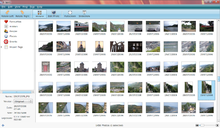

 | |

Browsing images in F-Spot
| |
| Original author(s) | Ettore Perazzoli |
|---|---|
| Developer(s) | Larry Ewing, Stephane Delcroix, Gabriel Burt, Ruben Vermeersch, Timothy Howard, Stephen Shaw |
| Stable release |
0.8.2[1] |
| Repository | github |
| Written in | C# (GTK#), C++ |
| Operating system | Linux |
| Platform | Mono, GNOME |
| Type | Image organizer |
| License | MIT 0.0.1 to 0.8.2: GPL-2.0-only[2] |
F-Spot is an image organizer, designed to provide personal photo management for the GNOME desktop environment. The name is a play on the word F-Stop. F-Spot can be used for basic photo editing and management.[3]
The F-Spot project was started by Ettore Perazzoli and was maintained by Stephen Shaw. F-Spot is written in the C# programming language using Mono.[4]
Before its discontinuation in 2017, F-Spot was the standard image tool for several GNOME based distributions. Before that, Fedora replaced F-Spot with Shotwell in Fedora 13.[5] Ubuntu also replaced it with Shotwell in 10.10 Maverick Meerkat.[6][7]
F-Spot aimed to have an interface that is simple to use but also facilitates advanced features such as tagging images, and displaying and exporting image metadatainExif and XMP formats. F-Spot has been noted as being similar to iPhoto.[8]
All major photographic image formats are supported, including JPEG, PNG, TIFF, DNG, GIF, SVG and PPM, as well as several vendor-specific RAW formats (CR2, PEF, ORF, SRF, CRW, MRW and RAF).[9] As of 2008, the RAW formats were not editable with F-Spot. However, newer releases of F-Spot have the DevelopInUFRaw extension, which calls on UFRaw for the conversion work, and then re-imports the resulting JPEG back into F-Spot as a new version of the original RAW.
Photos can be imported directly from the camera. The driver support is provided by libgphoto2. The GNOME desktop environment can also optionally detect if a camera or a memory card has been attached, and import images to F-Spot automatically. Photo CDs can be created by selecting multiple photographs and selecting "Export to CD" from the main menu.[10]
F-Spot has a photo tagging feature which allows for photos to be organized based on user-defined tags or generic pre-included tags such as favorites.[11][12]
Basic functions such as crop and rotate available alongside more advanced features such as red-eye removal and versioning. The rotate function allows for movements in single degree increments with autocrop, not just 90-degree adjustment. Color adjustments are supported with a histogram. They include an auto-improve and individual brightness, contrast, hue, saturation and temperature.
Photos in the F-Spot library can be uploaded to a number of online photo storage sites. F-Spot exporting to websites such as Flickr, SmugMug, 23hq, and Picasa Web Albums, and also using stand-alone web gallery software, such as Gallery.[10][9] F-Spot can also generate static web gallery sites and export to Facebook. F-Spot automatically downsizes photos before exporting to Flickr, and though it describes this as "optional," there is no option to not downsize photos before export.[citation needed]
When images are imported into F-Spot, they are written to disk. The folder is /username/Pictures/Photos/[year]/[month]/[Day].
|
| |||||||||||||||||
|---|---|---|---|---|---|---|---|---|---|---|---|---|---|---|---|---|---|
| Core Applications |
| ||||||||||||||||
| Extras |
| ||||||||||||||||
| Components |
| ||||||||||||||||
| Community |
| ||||||||||||||||
| People |
| ||||||||||||||||
| |||||||||||||||||
|
| |||||||
|---|---|---|---|---|---|---|---|
| Free software |
| ||||||
| Proprietary |
| ||||||
| |||||||